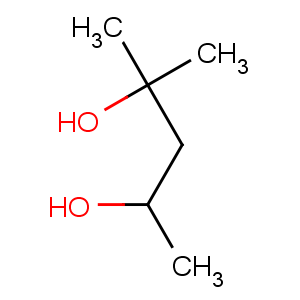Title: Hexylene Glycol
CAS Registry Number: 107-41-5
CAS Name: 2-Methyl-2,4-pentanediol
Synonyms: a,a,a¢-trimethyltrimethyleneglycol; pinakon
Molecular Formula: C6H14O2
Molecular Weight: 118.17
Percent Composition: C 60.98%, H 11.94%, O 27.08%
Literature References: Prepn: Franke,
Monatsh. Chem. 22, 1067 (1901); Leopold,
DE 486767 (1925 to I. G. Farben),
Frdl. 16, 679; Adkins, Cramer,
J. Am. Chem. Soc. 52, 4349 (1930); Arundale, Mikeska,
US 2367324 (1945 to Standard Oil). Toxicity study: Smyth, Carpenter,
J. Ind. Hyg. Toxicol. 30, 63 (1948).
Properties: Liquid. Mild sweetish odor. d1515 0.924. bp760 198°; bp10 97°. Flash pt (open cup): 93°C (200°F).
nD20 1.4276. Dipole moment: 2.8. Viscosity at 20° = 34 cP. Sol in water, alcohol, ether, lower aliphatic hydrocarbons. LD50 orally in rats: 4.70 g/kg (Smyth, Carpenter).
Boiling point: bp760 198°; bp10 97°
Flash point: Flash pt (open cup): 93°C (200°F)
Index of refraction: nD20 1.4276
Density: d1515 0.924
Toxicity data: LD50 orally in rats: 4.70 g/kg (Smyth, Carpenter)
Derivative Type: Diacetate
Molecular Formula: C10H18O4
Molecular Weight: 202.25
Percent Composition: C 59.39%, H 8.97%, O 31.64%
Properties: Liquid. bp12 95°.
Boiling point: bp12 95°
CAUTION: Potential symptoms of overexposure are irritation of eyes, skin, respiratory system; headache, dizziness, nausea, incoordination, CNS depression; dermatitis, skin sensitization.
See NIOSH Pocket Guide to Chemical Hazards (DHHS/NIOSH 97-140, 1997) p 164.
Use: Cosmetics, hydraulic brake fluids (as coupling agent to castor oil).

